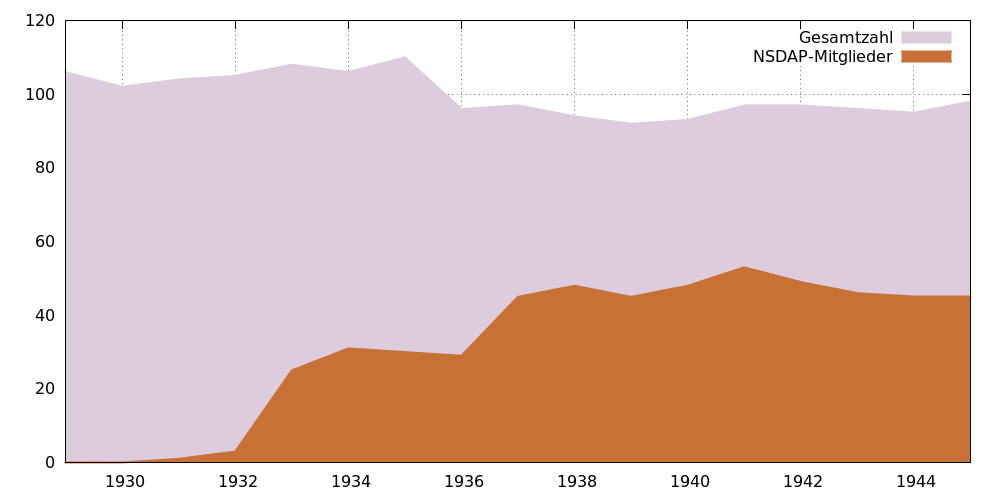- The University
- 1933-1945
- Women
- Buildings
- Professors
- Origin
- Denomination
- Appointment age
- Honors
- Increase in professorship
- Professors as veteran
- Wordcloud
- License
- About
Die Christian-Albrechts-Universität in den Jahren 1933 bis 1945
Die NS-Zeit hat die deutschen Universitäten tiefgreifend verändert. 1933 begann die per Gesetz verordnete Gleichschaltung der Hochschulen, in deren Folge missliebige Hochschullehrer, v. a. „Nicht-Arier“ und politisch Andersdenkende, zwangsversetzt, -emeritiert oder entlassen wurden. Ein prominentes Beispiel für einen vertriebenen Kieler Wissenschaftler ist Walther Schücking, der der Deutschen Demokratischen Partei (DDP) angehörte und schon von der Machtübernahme nationalsozialistischen Anfeindungen ausgesetzt war. Am 25. April 1933 wurde er beurlaubt und starb zwei Jahre später in Den Haag.
Gleichzeitig wurden die Hochschulen nach dem „Führerprinzip“ hierarchisch neu geordnet; die institutionellen und personellen Veränderungen mussten sich letztlich auch auf Forschung und Lehre auswirken. Die Christiana Albertina, die sich wegen ihrer Nähe zu Dänemark als eine „Grenzlanduniversität“ verstand, sollte, vor allem unter den Rektoren Georg Dahm, Paul Ritterbusch und Hanns Löhr, umfassend „politisiert“ werden und damit einen Beitrag zur „Volkstumsarbeit“ leisten. Wie dieser Beitrag der einzelnen Wissenschaftsdisziplinen zu den Vorhaben der NS-Führung allerdings konkret aussehen sollte, gaben weder die zuständigen Stellen in Berlin noch die regionalen Instanzen dezidiert vor. Die Hochschulangehörigen waren entsprechend einerseits dem starken Druck ausgesetzt, im Sinne des Nationalsozialismus zu forschen und zu lehren, ohne aber andererseits genauere Vorgaben dazu zu haben, wie dies in der Praxis umzusetzen sei.
Ein Feld der Hochschulpolitik, das von verschiedenen Staats- und Parteistellen intensiv betrieben wurde, war die Personalpolitik. Neben fachwissenschaftlichen und pädagogischen Fähigkeiten bewertete man auch die politische Einstellung der Kandidaten. Zugeständnisse an den Nationalsozialismus, worunter u.a. die Mitgliedschaft in der Nationalsozialistischen Deutschen Arbeiterpartei (NSDAP) oder einer ihrer Unterorganisationen zählen, konnten die eigene akademische Karriere entsprechend voranbringen. Die folgende Graphik zeigt die Entwicklung der NSDAP-Mitglieder unter den 303 zwischen 1932 und 1942 in Kiel lehrenden Professoren:

Beitrittsdaten der NSDAP-Mitglieder unter den Kieler Professoren von 1932-1942
Deutlich sichtbar ist der stufenförmige Anstieg der Kurve, der v.a. auf zwei Ereignisse zurückzuführen ist: Die erste Beitrittswelle im Jahr 1933, als sich die Zahl der Mitglieder unter der Kieler Professorenschaft von 19 auf 81 erhöhte, also auf einen Schlag vervierfachte, fällt auf die Zeit nach den Reichstagswahlen im März des Jahres, als ein Beitritt vielen aus Karrieregründen opportun erschien. Zudem durften erstmals auch Beamte und staatliche Angestellte der Partei angehören. Von den langjährigen Parteigenossen wurden diese neuen Parteimitglieder als „Märzgefallene“ bezeichnet. Da man eine „Überschwemmung“ der NSDAP mit Opportunisten fürchtete, wurde eine Aufnahmesperre verhängt, die am 1. Mai 1933 in Kraft trat und von der erst 1937 wieder abgerückt wurde, sodass die Zahlen in diesem Zeitraum stagnieren. Als man die Aufnahmesperre 1937 wieder lockerte, kam es zur zweiten großen Beitrittswelle, im Zuge derer sich die Zahl der Parteimitglieder unter der Kieler Professorenschaft nochmals beinahe verdoppelte (von 81 (1933) auf 153 (1937)). Aufgehoben wurde die Sperre im Mai 1939. Seit diesem Jahr waren außerdem neue Verbeamtungen an eine Parteimitgliedschaft gebunden, sodass sich viele Nachwuchswissenschaftler zum Beitritt gezwungen sahen. Im Jahre 1942 schließlich waren 173 der Professoren der Christiana Albertina in der NSDAP. Insgesamt betrachtet waren im vorliegenden Zeitraum von 303 Professoren 181 NSDAP-Mitglieder, was einer Quote von 60% entspricht. Hierbei muss allerdings berücksichtigt werden, dass eine Parteimitgliedschaft allein nur wenig über die tatsächliche politische Einstellung aussagt. Ob jemand aus rein karrieristischen Motiven beitrat und entsprechend nur formelles Mitglied war oder ob er mit der NS-Ideologie ganz oder partiell übereinstimmte, kann – wenn überhaupt – nur durch umfassendere biographische Studien geklärt werden, wofür das Kieler Gelehrtenverzeichnis als Grundlage dienen kann.
Zum Weiterlesen:
- Christoph Cornelißen und Carsten Mish (Hrsg.): Wissenschaft an der Grenze. Die Universität Kiel im Nationalsozialismus. Essen 2009 (Mitteilungen der Gesellschaft für Kieler Stadtgeschichte, 86; „zeit + geschichte“, 14).
- Martin Göllnitz: Das 'Kieler Gelehrtenverzeichnis' in der Praxis. Karrieren von Hochschullehrern im Dritten Reich zwischen Parteizugehörigkeit und Wissenschaft, in: Jahrbuch für Universitätsgeschichte 16 (2013), S. 291-312.
Autorin: Lisa Kragh
 German
German English
English